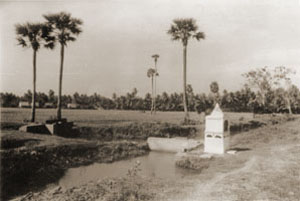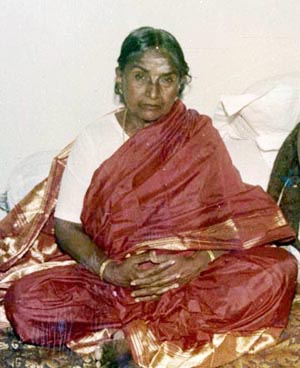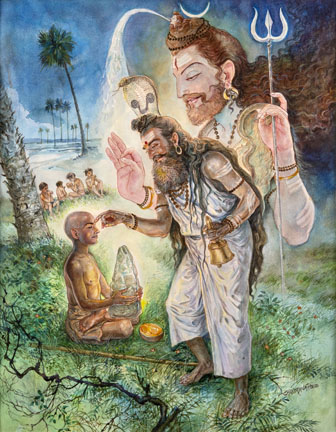HIS LIFE HOME PAGE | PREVIOUS PAGE | NEXT PAGE


A small shrine marks the place where Shivabalayogi was initiated into tapas. Nearby are some palmyra trees.

Swamiji's mother,
Parvatamma Allaka.
Shivabalayogi often praised her as the person who protected him
most throughout
his
severe, twelve-year tapas.
Shivabalayogi on samadhi.
Shivabalayogi on his tapas.
Initiation into Tapas
Sathyaraju had been known as a trouble-maker, with little if any propensity towards religion or spirituality. That village life ended abruptly on the afternoon of August 7, 1949. He was only fourteen.
Sathyaraju had been swimming with friends in an irrigation canal of the Godavari River just outside the village. They found some palmyra fruit which they shared among themselves. Sathyaraju squeezed the sweet juice from his piece of fruit when he felt a vibration from the fruit in his hands. He was overcome by the cosmic sound of Aum and a powerful light. Then he saw a black Shivalinga, an ovoid-shaped form of the divine soul that is Shiva. From the Shivalinga emerged a man.
He was over seven feet tall and beautifully proportioned. To Sathyaraju, the man looked like a jangamma devara, an ascetic who worships and dresses like Lord Shiva, God in the form of a yogi. His dark skin appeared smeared with light ash. He wore a white cloth (dhoti) wrapped around his waist, a necklace of rudraksha beads, and his matted hair piled on top of his head, all in the manner of the yogis of ancient times. He was extremely handsome with large, beautiful eyes. A bright light emanated from him, and all Sathyaraju could see was the yogi and the divine light.
The divine yogi instructed the boy to sit, then touched him between the eyes. Sathyaraju immediately passed into samadhi, a state of blissful consciousness in which the mind is still and there is no awareness of the body or time.
The other boys saw and heard nothing of these events. Their senses could not perceive the divine yogi, the intense light, or the cosmic sound. The spiritual drama was completely hidden from them, as if nothing had happened. All they noticed was their ordinarily rambunctious playmate sitting with eyes closed as if in meditation.
Of course, they assumed he was acting. The boys teased Sathyaraju in an effort to make him get up. When that did not work, they tried to pull his legs straight, poked him with sticks, and hit him with fists. Sathyaraju was absorbed in divine bliss and unaware of his physical surroundings. His concentration in the divine light and sound was unbroken. Getting no response, the boys smeared sticky palmyra juice and mud over Sathyaraju’s body. He did not respond, so they roughly picked up his body and put it in the canal water. Still there was no response. Sathyaraju did not open his eyes or make the slightest flinch at the mistreatment.
The boys began to get scared that maybe Sathyaraju was not acting. Maybe something bad had happened to him. Maybe he was dead and they might get blamed. They picked him up, washed him off, and left him sitting on the canal bank while they ran to the village to tell people that something strange had happened.
Sathyaraju remained in samadhi for almost the entire day, and continued his meditation for days, then weeks, months and years.
 Adivarapupeta Balayogi
Adivarapupeta Balayogi
Each night, he resumed his meditation. For eight years, he meditated in samadhi for twenty-three hours every day. He mastered the powers of each of the cardinal directions, north, south, east and west. For another four years, he meditated at least twelve hours each day. There were periods when he remained in samadhi for weeks at a time. He became known as the balayogi (“boy-yogi”) of Adivarapupeta.
"Swamiji as Sathyaraju was born in a very poor family and had to live a difficult life right from birth. He even had to work to earn a living to support himself and his family members at the young age of five. He therefore was used to hardship even before he was sat in tapas. In contrast, Gautham Buddha was born a prince and his parents took a lot of care to see that he did not face any hardship as he grew up. He had lived a luxurious life. Just try to imagine how hard it would have been for Buddha to undergo the difficulties of tapas. And unlike Swamiji, Buddha left the palace, relinquished his kingdom and even left his wife and a young son."
"Tapodeeksha" (Initiation into Tapas).
Painting by Chandranath Acharya
HIS LIFE HOME PAGE | PREVIOUS PAGE | NEXT PAGE



